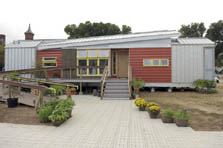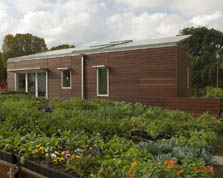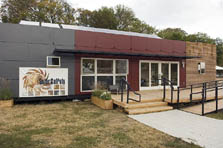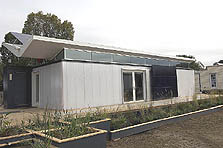

University of Colorado, Denver and Boulder, First Place

Cornell University, Second Place

California Polytechnic State University, Third Place

Virginia Polytechnic Institute and State University, Architecture and Dwelling contests winner
Solar Decathlon 2005
Final Results
The overall winners of the Solar Decathlon and the winners of the ten contests are listed here. For more information about the final results, see the final scores and standings summary (PDF 176 KB) or view the complete scoring spreadsheet (Zip 13.5 MB), which contains very detailed information about each team's results in each contest.
- Overall
- Architecture and Dwelling Contests
- Documentation, Communications. and Getting Around Contests
- Comfort Zone and Hot Water Contests
- Appliances and Lighting Contests
- Energy Balance Contest
Overall
First Place
University of Colorado, Denver and Boulder
University of Colorado students looked at the scoring spreadsheet, considered the weather, calculated the number of points they could gain in which contests, and developed a strategy to win. Or, as their faculty advisor, Mike Brandemuehl put it, "all the engineers were dorking out with the data." To ensure success in their strategy, they took a gamble on the weather. But they also looked at about five different weather reports each day, just in case they needed to change strategies.
Their strategy included gaining points in the competition by using the energy they managed to collect on a series of very cloudy days to keep their car charged. By driving more than any other team, Colorado won the Getting Around Contest. Colorado also placed first in the Communications and Documentation Contests, and second in the Appliances Contest.
View photos in the Gallery of Homes.
Second Place
Cornell University
The Cornell University team followed a similar strategy to Colorado. In fact, had they managed to "tail gate" Colorado a bit closer, who knows what might have happened? They came in second in the Getting Around Contest, and the Appliances Contest. Cornell took first in the Comfort Zone Contest, successfully keeping their humidity within the optimal range, and the team won the Hot Water Contest.
View photos in the Gallery of Homes.
Third Place
California Polytechnic State University
Cal Poly scored high in design. Jurors and Judges gave them second place in both the Architecture Contest and the Dwelling Contest. They took first place in the Appliances and Lighting Contests. They impressed the judges with their lighting design, and they kept their lights powered. They also scored high in the Hot Water contest, missing only one required shower test.
View photos in the Gallery of Homes.
Winners of the ten, individual Solar Decathlon Contests:
Architecture and Dwelling Contests
Virginia Polytechnic Institute and State University
In their evaluations for the Architecture Contest, the Architecture jury was unanimous in its assessment of the Virginia Tech team's house: "absolutely exquisite." The jurors had the sense that absolutely nothing had been overlooked. And most important, they sensed that the team had worked particularly well as a team. There were no obvious seams between the conventional divisions of architecture, engineering, interior design, and so on. They agreed that it was an extraordinary achievement on every level.
The panel of judges for the Dwelling Contest noted several impressive features in the Virginia Tech design. They report that, "everything about the design is clever," from the method developed to transport the light-construction structure to the user-friendly interactions with the sophisticated systems within the house. They also noted the "good flow" in the house. The judges said they could envision people living comfortably in the house, and that the house is buildable. They believe that the design could go into production right away.
View photos in the Gallery of Homes.
Documentation, Communications, and Getting Around
University of Colorado, Denver and Boulder
The Documentation Contest rewards the team that does the best job illustrating and analyzing their home's design. Panels of judges chose Colorado's "as-built" drawings as the best set, and the schematic energy analysis of their home's design as second best. The team also scored very highly in all other aspects of the contest, including successfully delivering a long list of project deliverables on time.
Both the Web site and House tour panels of judges unanimously chose Colorado as the winner of the Communications Contest. The Colorado team chose creative and accessible ways of communicating on their Web site and within their house. Their Web design is clean and fresh while their writing style on the Web is snappy, fun, and clear, covering a lot of content.
Colorado also won the Getting Around Contest. They knew how best to drive the car, and the best time to charge it. One team member made it his job to know how to get the best mileage out of the car. Each day during the competition, they set the bar for points awarded for Getting Around, and, in the end, they drove the most miles.
View photos in the Gallery of Homes.
Comfort Zone and Hot Water Contests
Cornell University
As the top-place team in both the Comfort Zone and Hot Water Contests, the Cornell team demonstrated how good engineering design integrated with building architecture will successfully result in good indoor environmental quality and meet all the household's hot water needs. For Comfort Zone, Cornell incorporated advanced technologies to ensure they maintained competition temperature and humidity requirements throughout the week. The Engineering panel of judges, which evaluated aspects of both contests, said Cornell's hot water system was a solid design that worked quite well. Most notably, however, Cornell was the only team to successfully complete all nine of the shower tests conducted during the competition.
View photos in the Gallery of Homes.
Appliances and Lighting Contests
California Polytechnic State University
Good planning is what led Cal Poly to a win in the Appliances Contest. The team managed their energy supply to successfully complete more of the contest tasks than any other team. They operated their TV/video and computer, prepared meals, ran their dishwasher, and washed their clothes using hot water (this in itself is a notable accomplishment considering the week's weather) while at the same time making sure their refrigerator and freezer temperatures consistently stayed within the allowed temperature range.
Cal Poly also won the Lighting Contest. Their architecturally-integrated lighting design not only met the competition requirements, it also contributed significantly to the comfortable visual environment of their home's interior. The Lighting panel of judges said the daylighting was bright and all encompassing, and that the team had succeeded in completing an extremely elegant design. The judges found the electric lighting system to be equally impressive. They noted Cal Poly's use of up and down lighting was "wonderful," and they appreciated how the team used accessible technologies and fixtures and integrated them into a beautiful lighting design.
View photos in the Gallery of Homes.
Energy Balance Contest
Crowder College, Florida International University, University of Missouri-Rolla and Rolla Technical Institute
In any other week, meeting the requirements of the Energy Balance Contest would probably have been a winning strategy for the overall competition. But because of incredibly unlucky and improbable weather conditions this year, that wasn't so. The three teams that tied to win Energy Balance—Crowder, Florida International, and Missouri-Rolla—committed to a strategy that was risky in the competition but provided an important demonstration to the public about just how energy efficient the houses are.
View photos in the Gallery of Homes: Crowder College, Florida International University, University of Missouri-Rolla and Rolla Technical Institute.
